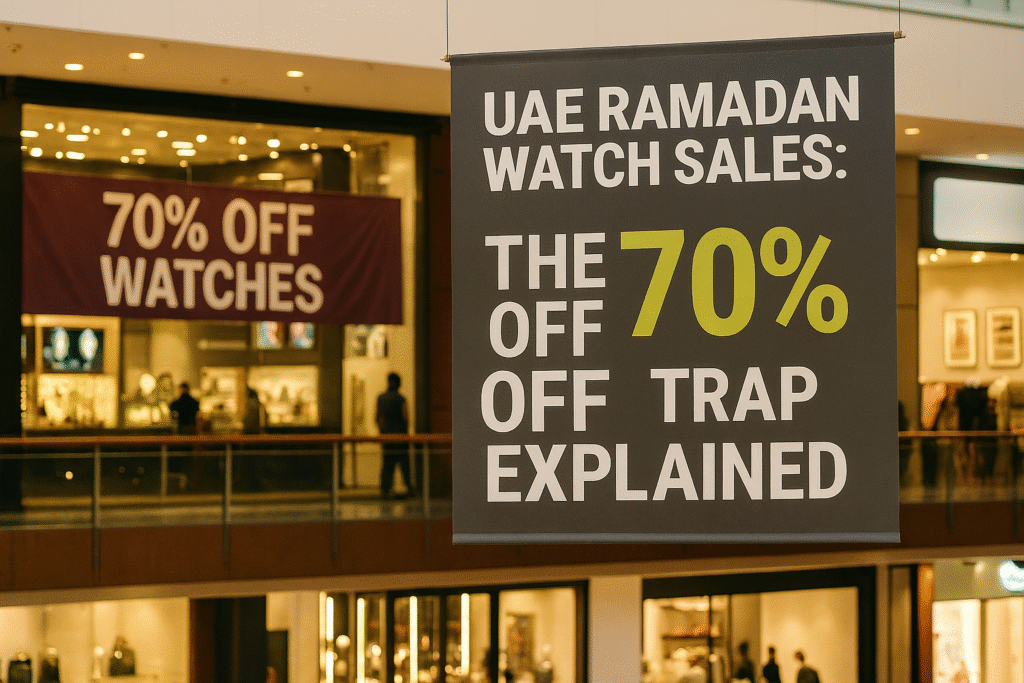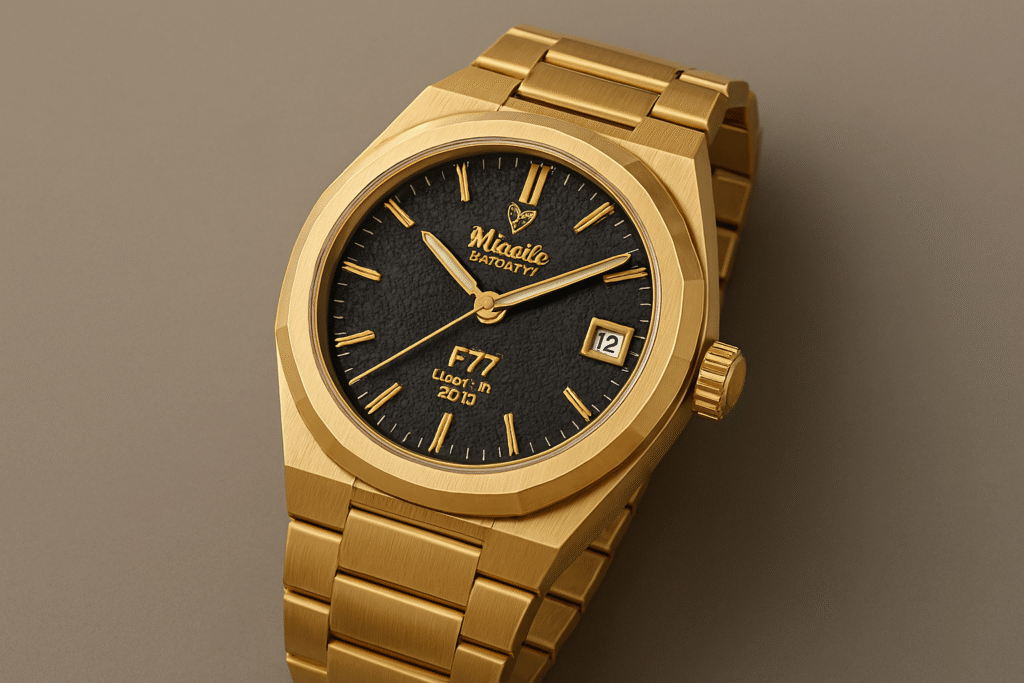Quick Answer: Are Ramadan Watch Discounts in the UAE Real?
UAE Ramadan Watch Sales attract thousands of shoppers each year, promising huge 70% discounts on luxury watches. In reality, most of these “offers” rely on inflated original prices, making it hard to find genuine bargains. The key is understanding how these sales operate, comparing prices, and spotting real deals before buying.
Table of Contents
- Why Dubai Watch Sale Deals Look Attractive
- How Ramadan Shopping Festival Watches in UAE Are Marked Up
- Real-Life Examples from UAE Watch Sales
- How to Check If Discounts Are Genuine
- Practical Tips for Buying Watches During UAE Ramadan Sales
- FAQ
Why Dubai Watch Sale Deals Look Attractive
During Dubai watch sale deals, malls and online platforms promote heavy discounts. Posters and online banners showcase luxury watches at slashed prices. Shoppers are drawn to the perceived prestige and bargain.
Market research shows that over 60% of Ramadan luxury watch offers in UAE malls are priced above global retail averages.
How Ramadan Shopping Festival Watches in UAE Are Marked Up
Retailers use anchor pricing. A watch normally priced at AED 2,000 may be listed at AED 5,000 pre-Ramadan. When the “70% discount” appears, it drops to AED 1,500. Buyers feel they saved big, but real savings are minimal.
The key is to check the true market price before trusting flashy discounts.
Real-Life Examples from UAE Watch Sales
- Omega Seamaster: Pre-Ramadan AED 15,000 → Inflated AED 25,000 → Ramadan “deal” AED 12,500. Actual saving: 16%.
- Fossil Chronograph: Global online AED 450 → UAE pre-sale AED 800 → Ramadan offer AED 499. Actual saving: ~AED 50.
Check global marketplaces like Chrono24 to verify prices.
How to Check If Discounts Are Genuine
- Compare prices internationally via brand websites.
- Look for official hallmarks and certifications (see Understanding BIS Hallmark: What It Means for Your Jewellery).
- Monitor mid- and high-end watches on global platforms like Chrono24.
- Track UAE mall prices over time.
Practical Tips for Buying Watches During UAE Ramadan Sales
- Shop in the final three days of Ramadan, when real discounts appear.
- Request receipts showing pre-sale prices.
- Stick to trusted retailers in Dubai Mall or Mall of the Emirates.
- Cross-check prices online before buying.
For more tips, see 24K, 22K, 18K: What Every Malayali Gold Buyer Must Know and Expert Experience in Gemology and Luxury Watches
FAQ
Q1: Are UAE Ramadan watch sales always fake?
No. Genuine deals exist, mostly on outlet or clearance models.
Q2: What is the typical real discount?
Average savings range between 10–25%.
Q3: Should I shop online or in malls?
Online platforms like Amazon.ae are often more transparent, but always compare prices.
Q4: How do I spot inflated prices?
Check at least two UAE retailers and the brand’s global website for reference.
This comprehensive global cuisine FAQ covers everything about Asian and Western food and drinks. Whether you’re exploring international cooking techniques or discovering new flavors, this global cuisine FAQ answers the most frequently asked questions about world food traditions, ingredients, and culinary practices from both Eastern and Western cultures.
Global Cuisine FAQ: Asian & Western Food & Drinks
Food reveals cultural contrasts in clear and delicious ways. From cooking methods to dining customs, Asian and Western cuisines showcase unique traditions while also offering fascinating overlaps. Below, you’ll find answers to the most common questions about these culinary worlds.
Understanding Core Differences in Cuisine
1. What distinguishes Asian and Western culinary traditions?
Asian meals often rely on rice or noodles as a foundation. Flavors usually come from soy sauce, ginger, garlic, and a wide variety of spices. Meanwhile, Western gastronomy emphasizes bread, potatoes, and pasta. Dairy plays a key role, with butter, cream, and cheese giving richness to many dishes. Herbs such as rosemary and thyme highlight European cooking. These contrasts create distinct dining habits and flavor profiles.
2. Are Asian dishes always spicy?
No, not at all. While cuisines from Thailand and parts of India feature bold use of chilies, not every dish follows this pattern. Japanese sushi, Chinese dim sum, and Korean bulgogi are mild examples. In fact, Asian cuisines range from fiery to delicate, showcasing a rich palette of flavor.
Western Breakfast Staples and Comfort Foods
1. What constitutes typical Western morning meals?
Western breakfasts often include eggs, bacon, and toast. Pancakes, waffles, and cereal are also popular choices. These hearty starts are usually enjoyed with coffee, tea, or juice, providing both energy and comfort.
2. What represents popular Western comfort foods?
Comfort foods in the West speak to nostalgia and indulgence. Creamy macaroni and cheese, pizza, and hearty casseroles are favorites. Similarly, burgers and fried chicken have wide appeal. Because they are warm, filling, and familiar, these dishes strongly connect to emotion.
Cultural Dining Practices
1. Do all Asian cultures employ chopsticks?
No. Chopsticks dominate in East Asia—China, Japan, and Korea. However, Southeast Asia prefers spoons and forks, while India and parts of the Middle East often use flatbreads or hands. This diversity highlights how food customs closely reflect culture.
2. Why are some Asian foods fermented?
Fermentation preserves food while also enhancing nutrition and flavor. Korean kimchi, Japanese miso, and Indonesian tempeh show how tradition meets health benefits. These foods are valued not only for taste but also for their role in well-being.
Common Western Beverages
1. What beverages are common with Western meals?
Western dining often features water, soda, or fresh juice. Alcohol also has a strong cultural connection, with wine served at European dinners and beer central in North America. In the southern United States, sweet iced tea is a staple.
Dietary Flexibility and Options
1. Can one discover plant-based options easily?
Yes. Asian cuisines offer tofu stir-fries, lentil dals, and vegetable curries that are naturally vegetarian. Western food, similarly, embraces plant-based eating. Salads, vegetarian pastas, and vegan burgers have grown popular, making meat-free dining accessible worldwide.
Unique Asian Drinks to Explore
1. What are some unique Asian beverages?
Asia provides a wide variety of distinctive drinks. Bubble tea, from Taiwan, combines tea with chewy tapioca pearls. Japanese sake, made from rice, holds deep cultural meaning. Strong Vietnamese iced coffee, sweetened with condensed milk, adds a bold twist compared to Western brews.
Portion Sizes and Dining Habits
1. How do portion sizes compare?
Western meals often emphasize large servings, reflecting abundance. By contrast, Asian meals are usually smaller yet balanced, encouraging sharing and mindful eating. This creates different social experiences around the table.
The Art of Fusion Cuisine
1. Is it feasible to integrate Asian and Western flavors?
Absolutely. Fusion cuisine blends traditions in creative ways. For instance, teriyaki burgers combine Japanese flavors with American fast food, while kimchi tacos bring Korean spice to Mexican street food. These playful mixes show how food bridges cultures.



